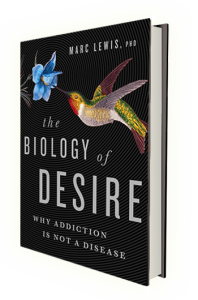 I’ve been working with a client (I’ll call him Robert) who’s trying to stop using cocaine. We’ve had some powerful sessions lately, emotionally moving for me as well as for him. I really want to help Robert — or, more to the point, I want him to succeed, with or without my help. He’s just so miserable, so alone, so desperate.
I’ve been working with a client (I’ll call him Robert) who’s trying to stop using cocaine. We’ve had some powerful sessions lately, emotionally moving for me as well as for him. I really want to help Robert — or, more to the point, I want him to succeed, with or without my help. He’s just so miserable, so alone, so desperate.
And I recognize myself in him. Not because I’m miserable and desperate these days (I’m not) but because I know exactly what it feels like to be in that place. To continue using when the pleasure is gone and the heartache starts to geyser up before you’ve even left the house to score.
One plan that made sense for Robert was to enhance self-compassion as a means for overcoming (a massive glut of) shame…(because, as we know, more shame –> more using). But then it occurred to me that the format of the plan (in therapy or in life) is more important than the content. The content will vary from one person to the next. Yet there may be one maximally effective format for beating addiction: connecting a macro project with a micro project. What I mean is, developing some skill or resource that takes time to build and refine (that’s the macro project), and deriving from it a toolkit of strategies one can activate in the moment (the micro project).
Most important, the two have to connect. What’s going to be most useful in the moment (e.g., when your dealer calls, when you’ve just had a fight with your husband, when your best friend has to go home to his family for dinner) is going to be something you’ve worked on over time.
A case in point: developing self-compassion to beat shame
The macro project: We each have a number of different selves, or voices, or modes or moods, whatever you want to call them. Each is distinct, built on a particular emotion or emotional combo. The shameful self — that’s pretty familiar. Hating to be seen, cringing from being accused or  despised by others…and by oneself. Shame is hot, red like a boil, painful, laced with disgust. The shamed self often gives way to anger, the famous fuck-you reaction, or defiance, the equally famous fuck-it solution. Or it opens onto
despised by others…and by oneself. Shame is hot, red like a boil, painful, laced with disgust. The shamed self often gives way to anger, the famous fuck-you reaction, or defiance, the equally famous fuck-it solution. Or it opens onto  guilt and depression. Omigod, how could I have done that?! What a bastard I am. Then there’s the anxiety about being caught, seen, punished, cast out — as familiar as background music to Robert and to just about everyone I know in active addiction. Often there’s a cascade through several of these self-states that leads straight to using. But each state is also a branch of our personality, stable and familiar — a thicket of interlaced neurons.
guilt and depression. Omigod, how could I have done that?! What a bastard I am. Then there’s the anxiety about being caught, seen, punished, cast out — as familiar as background music to Robert and to just about everyone I know in active addiction. Often there’s a cascade through several of these self-states that leads straight to using. But each state is also a branch of our personality, stable and familiar — a thicket of interlaced neurons.
 Yet there’s another self, built on another feeling. It’s the compassionate self, based on the feeling of nurturance. Nurturance is built into our neural hardware. It’s needed for us (great apes) to effectively raise our young, since they take forever to mature. It’s
Yet there’s another self, built on another feeling. It’s the compassionate self, based on the feeling of nurturance. Nurturance is built into our neural hardware. It’s needed for us (great apes) to effectively raise our young, since they take forever to mature. It’s  the feeling we feel when we comfort a child or feed a helpless animal. But, as you probably know, the compassionate self seems a fiction, a fantasy, when you’re in active addiction, especially when it comes to compassion for yourself. Maybe you never learned self-compassion deeply enough because your parents didn’t know how
the feeling we feel when we comfort a child or feed a helpless animal. But, as you probably know, the compassionate self seems a fiction, a fantasy, when you’re in active addiction, especially when it comes to compassion for yourself. Maybe you never learned self-compassion deeply enough because your parents didn’t know how  to provide it or feel it or value it. Or maybe you lost it en route. It gets worn thin by repeated bouts of shame and self-loathing.
to provide it or feel it or value it. Or maybe you lost it en route. It gets worn thin by repeated bouts of shame and self-loathing.
But either way, self-compassion is pretty much the only feeling that can defeat the self-destructive agony of shame in a head-to-head fight.
 In The Biology of Desire I described self-compassion as one way to connect your past self (recognizing how much you’ve been hurt) with your present self (of course I want to get high — that’s how I’ve learned to hurt less) with your future self (we’re going to get to a better place — here we go). Note the use of “we” — and (P.S.) see Peter Sheath’s and Matt’s comments directly below.
In The Biology of Desire I described self-compassion as one way to connect your past self (recognizing how much you’ve been hurt) with your present self (of course I want to get high — that’s how I’ve learned to hurt less) with your future self (we’re going to get to a better place — here we go). Note the use of “we” — and (P.S.) see Peter Sheath’s and Matt’s comments directly below.
 Given that self-compassion looks like a field of dead weeds, the macro project is simple. Cultivate it. Grow it. Make it more familiar, more salient, more present. There are several ways to do this. ACT and self-compassion therapy are obvious choices. Check out other therapeutic approaches suggested by readers here and here. But what I recommended to Robert was to meditate, just 10 minutes in the morning for now, and start to sense it, like an almost totally blind
Given that self-compassion looks like a field of dead weeds, the macro project is simple. Cultivate it. Grow it. Make it more familiar, more salient, more present. There are several ways to do this. ACT and self-compassion therapy are obvious choices. Check out other therapeutic approaches suggested by readers here and here. But what I recommended to Robert was to meditate, just 10 minutes in the morning for now, and start to sense it, like an almost totally blind  person sensing light. Feel that first bit of coziness behind your eyelids, in your body, and stay with it, let it warm you. I suggested he try using a meditation app, like Headspace, Insight Timer, or Buddhify. These apps can help by connecting us to a voice that’s comforting as well as skilled. And DO IT every day until it starts to take — usually within a week. Also, just talking to yourself in a kind voice (either out loud or silently) can be very powerful. Try it.
person sensing light. Feel that first bit of coziness behind your eyelids, in your body, and stay with it, let it warm you. I suggested he try using a meditation app, like Headspace, Insight Timer, or Buddhify. These apps can help by connecting us to a voice that’s comforting as well as skilled. And DO IT every day until it starts to take — usually within a week. Also, just talking to yourself in a kind voice (either out loud or silently) can be very powerful. Try it.
The micro project: Most of us know that just being off drugs or booze for a few days is already a plus. Shame and self-reproach start to recede. Maybe you get a little pride, a sense of forward thrust. Some hope. Some trust in yourself. But stopping, even for one day, can be insanely difficult, so most forms of addiction treatment try to teach mental tricks for diverting or overcoming the urge.
These tricks include “fuck no!” (sort of the opposite of “fuck it” — using defiance for good, not evil). They include distraction, finding something else to do, exercise, sports, prayer, connecting to a friend or sponsor. They include avoiding temptations, focusing on future goals, “urge surfing,” finding a replacement substance that’s easier to quit. These cognitive acts can get you through the night. They’re the things you might learn from CBT, or motivational interviewing, or DBT, or SMART. And they are valuable!
But the one cognitive trick that’s usually missing from this list is, I think, the most valuable: finding your compassionate, accepting self, right here and now, because that softens and neutralizes shame (and averts the rest of the cascade). Now you have somewhere to go that isn’t agonizing, that feels good enough to replace getting high.
And the best way to make this micro project work is to link it with the macro project of finding and cultivating the compassionate self. Which may take weeks or months. It won’t happen overnight.
So my suggestion to people trying to help people in addiction, to people in addiction (like Robert) and to my own self is: Get to work on the macro project of cultivating the compassionate self WHETHER OR NOT there’s a smidgen of “improvement” when it comes to using — or anything else. And then, when it’s time, call on that self, get it on board, at 7:45 on a Friday night or a dreary Monday morning.
But you gotta do your homework, your macro project, first — at least get it started — or the micro project isn’t going to work very well.
 Informed by unparalleled neuroscientific insight and written with his usual flare, Marc Lewis’s The Biology of Desire effectively refutes the medical view of addiction as a brain disease. A bracing and informative corrective to the muddle that now characterizes public and professional discourse on this topic.” —Gabor Maté, M.D., author of In The Realm of Hungry Ghosts: Close Encounters With Addiction
Informed by unparalleled neuroscientific insight and written with his usual flare, Marc Lewis’s The Biology of Desire effectively refutes the medical view of addiction as a brain disease. A bracing and informative corrective to the muddle that now characterizes public and professional discourse on this topic.” —Gabor Maté, M.D., author of In The Realm of Hungry Ghosts: Close Encounters With Addiction
Hi Marc
What a wonderful blog. I will be leaving home shortly to sit with a guy in Liverpool working out his macro project, which is already mostly in place. I think that the getting in touch with with the “compassionate, accepting and, dare I say, loving” self can only really come through prosocial role modelling. It’s all those really human things about ourselves that get lost in childhood trauma and the continuous creation of a very false self based on coping with survival, hypervigilance and the stress of using. It becomes a kind of fear of being that little scared child, searching for love, that you feel inside so you must cover it up at all costs. Maybe it is only through meeting with someone who shares a similar lived experience that the coming together of the therapeutic relationship can occur? And, maybe, it’s only within that relationship that a safe space can be held, exploration and understanding can be formed and, hopefully, change can occur?
Peter, thank you for filling in the crucial role of love and of the interpersonal dynamics that unfold over development and then again in the present tense. This is a needed corrective to my implication that anyone can work through this process on their own.
Or as I’d say it, there’s got to be social in your macro and micro. I suspect that when 12 step programs work, it’s because of that social/role modeling that happens there.
For me, after decades of being very anti-12-step, I’ve realized that being accepted, and dare I say loved, by others has been invaluable to me. In fact, it pulled me back from a relapse this past June.
I was lucky. I’m not opposed to the “God as Higher Power” concept, so found my way to Celebrate Recovery, which ties the 12 steps to scripture. One of the things I like about the program is that it isn’t addiction-specific. In fact, you don’t have to be an addict to participate … the program is for anyone with a “hurt, hang-up, or habit” they are struggling with. So we have as many people dealing with co-dependency issues as there are addictions. And you’re not obliged to accept Jesus or anything, so unless you’re an avowed atheist, it might be worth a look.
But there’s also a Buddhist-inspired program called Refuge Recovery that might appeal to those with a more secular approach. And if you don’t live near either, then checking out the online In The Rooms website or app (www.intherooms.com) is available and uses webinar technology to connect with others (you don’t have to be on camera if you don’t want to be).
Hi Beth
Thanks for this important insight. I have some friends in Celebrate Recovery as well as in Refuge Recovery. It’s interesting the theme of addictive behavior– Addiction with a capital A– is common to both CR, RR and SMART Recovery…and even though SMART is secular, I have had at least three people in my groups that do both…or all three.
Yeah, just as an aside. I’m doing a step study at CR and our group of 12 women is VERY mixed … some there for (hard) addiction, some there for kids’ addiction issues, and some there for marital issues/codependency.
Last night a 30ish woman recovering from heroin was just telling me her resistance to CR at the beginning … she was like “what do these old church ladies know about addiction?”
And then she found out. 🙂
But I’ve heard from more than one of these younger folks that they’ve found CR far less judgmental than AA or NA. And the mixed approach (large group followed by smaller share groups) can be the best of both for some.
Thanks for this Marc! Long time no blogulation!
I think this gets to the point they make in 12-Step, that this is an “inside job”… but the problem is that I have so desecrated my mental and physical insides, it needs to start from the outside in, not the inside out…the “macro” you describe. We have to learn again to be honest with ourselves, so we start by being honest with others (partners, family, meetings, friends, therapists.) As you said, we are a social, affiliative, nurturing, atricial species. If we don’t bond to a caregiver from birth, we are dead. If it’s inconsistent or traumatic, we’re damaged. Substances and behaviors provide a relational respite from the loneliness. At its root, addiction is about survival.
So through being honest with others, we can be honest with ourselves, then trust ourselves; practice compassion with others so we can practice compassion with ourselves; believe in others, so we can believe in ourselves. Most people with addiction would agree we would never treat another human the way we treat ourselves.
This gets to a practical reason that meditation is so beneficial when done correctly. It relates to the “default mode network” that Marc’s mentioned in the blog before. It’s the state we’re in when our mind is wandering and not focused on anything in particular. It also is the seat of self-referential thinking, thinking about my status in my social group, theory of mind, etc..– even referred to as the neurobiological basis of the self. It’s about thinking about what’s gonna happen in the future, narratives about what happened in the past…NOT about being focused on what’s happening in the present moment. If my DMN is continually set on “I’m a piece of shit,” it’s not a healthy state to be in. It’s been shown in fMRI studies that expert meditators can actually turn off the DMN.
And what do we do when we meditate? We have a point of focus, like a mantra or the breath. When we notice our mind start to wander, we gently bring it back to the point of focus. Over and over, training the mind to focus, notice when we stray and come back. So where does the mind often wander off to? You guessed it. The DMN. When we meditate regularly, we are not only training our mind to focus… we are training it to let go of the toxic stories we tell ourselves, and come back to what’s happening right now. It puts distance between us and our toxic past, and in that distance we have the opportunity to make a different decision…
Matt, these are incredibly useful extensions. Thank you for these insights into the experiential and the neural substrates of this process. I agree with you 100%.
You might also want to check out David Treleaven’s book Trauma Sensitive Mindfulness (review here: psychcentral.com/lib/book-review-trauma-sensitive-mindfulness/).
Everyone has to deal with monkey mind, but if you’ve become an addict to run away from really scary interior voices, meditating can be downright terrifying.
Hi Beth. This looks like an important source, and of course you’re right that meditation, or any other experience of opening yourself up and relinquishing your defenses, can be overwhelming for someone who’s gotten used to an artificial inner life. Also, your comment above, concerning what you got out of 12 step groups, the enormity of feeling accepted, and the offshoots, Celebrate Recovery and Refuge Recovery, will be valuable pointers to many. I can’t always respond to every comment, but I really appreciate this contribution: you’re providing a concrete leg-up to some of the thousands of people who read this blog.
Hey Marc,
So your book was incredible. I have been clean for 18 months tomorrow and I must say re use fing your book helped me fill in a lot of blanks in areas that well they were just “idk”s. I’m writing to open communication and also because I am rereading the book and also because I am a member of NA. That being said i have a difficult time convey your information sometimes but mostly find that if my fellow members are inclined to believe that they aren’t “diseased” it’s really bk pt my place to try and convince them out of something that is working for them. I really especially identified with the portion of the book that talks about the misinterpretation of “admitting your powerless” which is the first step in 12. ( which I have committed to finishing I am on the 7th) anyways back to the point about your speaking to how empowered I was and am when I remember that I CHOSE to began replacing the terrible habit of injecting meth and heroin for over ten years really EMPOWERS AND DRIVES me. things such as reading, learning, prosocial events(lots of which were organized by na) and reconnecting with my family, working I have almost completed college which i flunked out of twice as a younger man. That was one of those blanks that helped me understand the biological and physiological processes that were taking place when I continued to remain abstinent from the chemicals that reeked havoc on my brain. So I’m 33 got high and wasted since I was teenager and then this perfect storm of events some potential for serious legal repercussions complete loss of relationship with parents, and I think just a general disgust for what I was doing and I put it all down and haven’t looked back, even nicotine. (18yr smoker). I read a book about complimenting habits and ditching them at same time. Conclusion your book was amazing and has forever changed (positively) the way I look at things that cause problems for me that I can control. I think I can honestly say I love ya, one human to another. If you have advice for handling how I try to explain this point about empowering another addict or even another person to take control that would be great my na brothers think I’m just a hippie or something for dismissing medical fields official stance. Lol lol 😜😜😜
I think I put this in the wrong spot now that I look at it
Keep questioning the Western medical paradigm Sean! It has many, many flaws, not least its economic underpinnings. Big Pharma gave us oxycontin, which was, I believe, initially billed as non-addictive. And now, “rehab” is a squillion-dollar industry.
Hi Karen yes I cant help but feel like the disease model is being spun to make lots of money. But when I listen to our readings and literature use the term “disease” although I cringe on the Inside, I still am seeing it work these miracles in people’s life it’s weird how it can be both devastated in a positive way and a negative way for some.
Sean, sorry I missed your comment, but I saw that others have been conversing with you, and that’s what this blog is all about. I don’t have specific methods for conveying “my message” to particular groups. As others have said, and as you imply, the disease model is really needed and helpful for some people in some contexts. I wouldn’t want to try to coerce them to give it up. But very often the disease concept is used to shoe-horn people into a belief that they can’t fix themselves. That’s where I want “my message” to be ready and waiting.
Thanks so much for your kind words. I get your love and send mine back. It is heart warming to connect with you through this medium of writing and blogging.
Edit
“If my fellow members are inclined to believe they are diseased then it’s not my place to tell them they are not”
I agree that it’s not your / my place to try and pull down others’ beliefs. But the disease model is just that – a model, based in the Western medical paradigm. Addiction is considered to be a disease because those scan thingies show that the brain changes as someone moves into addiction. But I think Marc has pointed out that the brain changes again as the person moves out of addiction, not back to what it was before, but to something different again. It seems the brain changes throughout life, in response to experiences. If the medical wonks want to call some subset of those changes “disease”, that’s their thing. It’s better than the addiction-as-moral-failing model, but it’s still only a *model* of reality.
And a rather simplistic model at that. (see next post) Yes, the model has some uses, but it also marshals our thinking in ways that obscure the true complexity and depth of addiction. Which, by the way, isn’t a thing in itself, but an aspect of living in a too-challenging world without adequate resources to deal with those challenges.
Thanks for responding Marc and this is a pretty neat outlet for me to continue my se as rich for perspective and information to use for increasing my worldview in a positive way rather than hammering home those artificial spikes in “feel good” that the drugs and activities gave me!! Appreciate the medium that’s provided 😉😁😁
Even western medicine’s definition of “disease” has a lot of limitations – doctors see diseases as discrete sets of symptoms, each of which can be “cured” by a single drug or procedure. By contrast, traditional Chinese medicine sees diseases as manifestations of an underlying imbalance in the body, which can be nudged back towards equilibrium using things like acupuncture and herbs.
Even physical diseases can be approached in different ways. If you have, say, high blood pressure, take your medication, yes. But if you also change your lifestyle, exercise, eat well, lose weight, and manage your stress levels, you will be much better off than someone who just took their medication.
Hi Sean
The idea of powerlessness didn’t make sense till I finally came around to the connotation that I believe was intended. People sometimes argue about being powerless when it’s in you, being powerless when it’s around you, being powerless when you are thinking about it… I used to wonder, “Well, if I’m totally powerless, how does anyone ever get sober?” I’ve come to realize that the most powerful part of admitting I’m powerless is that I ACCEPT the fact that I have a problem, and that I need help with it, and I can’t do it alone…and that in itself is empowering. People who get over this are no longer powerless. I don’t use and drink anymore because I don’t want to, not because I’m powerless.
Thanks matt I completely understand this perspective and believe that its empowering to understand the difference between being aware that I had a problem. I know CHOOSE not to use just cause i dont want to not because I’m powerless 😊😊😊
Marc Hi. In the rehab i work in we have recently worked with a Professor who in conjunction with his mates in England are developing what is called Compassion focused Therapy, a deviation of CBT that looks at self compassion. This is especially relevant in the population group i work with, Indigenous men, who already have shame from various directions and who due to punitive approaches especially towards drug sue are not helped by the attitudes of others towards drug users and alcoholics which only increase shame and self depreciation. We focus on treating our men as “normal” humans, not some diseased offshoot. After all, all humans have habits borne of the desire to feel secure and based on their self esteem that being developed in my view early in life. It the habits that are chosen that often decide what degree or otherwise of social judgment and thus increased shame a particular habit results in.
Marc, Hello, and another awesome post. I can’t overplay the role that meditation and the ensuing emotional and mental awareness has played in my ability to overcome the need to use addictive behaviors. (I haven’t had typical addiction problems for 23 years so I’m talking about the “everyday” addictions). Most importantly, and most recently, it made all the difference when I decided to leave my 12-step involvement since it gave me a structured practice in place of the structure that AA had provided, (as I wrote in my story for your blog), but more importantly it allowed me to be aware of the inevitable thoughts and feelings that arose like machine gun fire for a year after my move away from meetings (it has subsided now after three years). But I love the idea of macro vs. micro changes and will be stealing this wording (giving you credit, of course) in my own therapy practice. I know that for myself, it was so much easier to find and feel compassion for others way before it felt comfortable to include myself in this way. I still have to remind myself to include myself in my own compassion–how bizarre that still sounds. I will also recommend Sam Harris’s mediation App–waking up, as I have been using it (even as an experienced–albeit still a very beginner–meditator) and have been recommending it to any clients interested in beginning a meditation practice. I also wonder if there may be room for the discussion of macro and micro moves toward abstinence, obviously the idea behind some forms of harm reduction methods. Thanks again.
Here is an interesting publication in todays New York Times;
USING NEUROFEEDBACK TO FIGHT ADDICTION
https://www.nytimes.com/paidpost/university-of-dayton/the-researcher-using-neurofeedback-to-fight-addiction.html?cpv_dsm_id=190645439&tbs_nyt=2018-Aug-nytnative_hpmod
Hi Carlton. I’m really glad you brought this to my attention. First, note that it’s a paid advertisement; second, read it carefully and see if you can discern the flaws in the methodology and research design. I’m actually giving a talk at a neurofeedback conference this coming weekend, so I’m going to use this piece as a springboard for talking about radical unsubstantiated claims!!
Yes that is why I called it a “Publication”, not an “article” in the paper….in fact its more and “ad” if you will (!).
Hope you can share your talk, or some of it, from the conference 🙂
Very insightful posting, Marc. Dynamic systems in action, eh?
Exactly.
Wonderful post! Change can happen if the people around the person care enough to help him help himself. Love and support is everything.
Hey Marc. This all brings to mind my own experience with “Loving Kindness (Metta Meditation.) I learned it during 10 day retreats at a Vipassana Centre based on the teaching of Goenka. I remember it took me painful times in my past and I have returned to it. Now I practise it for 8 minutes each morning after a short meditative sit and more and more the people in my life come up, their names, their connections to me and even the ones I have hurt in the past and maybe never want to see or hear from me I can send loving kindness and something is healed inside. Very powerful. Thanks as usual